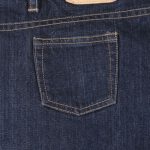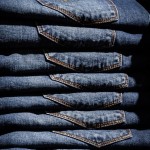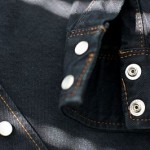When shopping for jeans, it’s important to consider whether they are made of raw or washed denim. Some people assume that “raw” and “washed” refer to specific types of denim. However, these terms actually reveal the way in which the denim was produced. Nonetheless, jeans made of raw denim have different characteristics than those made of washed denim and vise versa. By understanding the differences between these two common types of denim, you’ll have an easier time choosing the perfect pair of jeans.
Overview Raw Denim
Also known as dry denim, raw denim is denim that’s not washed before it’s sold. Denim is typically produced in several stages. Cotton is spun into a yard, after which the yarn is dyed a specific color, the most common of which is blue. Next, the dyed yarn is placed in a shuttle loom where it’s processed into ready-to-sell denim. When a company makes raw denim, it doesn’t wash the fabric. Rather, it proceeds to sell the unwashed denim to a jean or clothing manufacturing company.
Overview of Washed Denim
Washed denim, on the other hand, is denim that’s washed before it’s sold. It’s produced in the same way as raw denim, with cotton yard being dyed and then spun into denim. The fundamental difference is that washed denim is literally washed in water before it’s sold. Denim manufacturing companies take the dyed denim and wash it before selling it to a jean or clothing manufacturing company. The end result is washed denim, which many companies and consumers prefer.
The process of washing denim is known as sanforization. Sanforization involves more than just submerging denim underwater for a few minutes. It’s a time-consuming and extensive process that involves the use of a special machine, known as a sanforizing machine, that moistens denim with hot water. The sanforizing machine features a rotating cylinder that presses the denim fabric, causing it to compress. Sanforization has been around since 1930. And while new, more effective sanforizing machines have since been developed, the basic process remains the same: denim is exposed to pressure and hot water during the washing process, with the end result being washed denim.
Raw Denim Jeans Offer a Darker Tone
Both raw denim and washed denim have their own benefits. One of the benefits of choosing jeans made of raw denim, for example, is that it offers a darker tone. If you prefer jeans in a dark color like black or indigo, there’s better choice than raw denim. Since raw denim isn’t washed before it’s sold, jeans featuring this type of denim generally have a darker tone. The sanforization process (washing) essentially strips away some of the dye compounds added to the denim, resulting in a lighter tone. You can find jeans in a darker tone, though, by choosing raw denim. Raw denim isn’t washed before it’s sold, so it almost always has a darker tone than washed denim.
Washed Denim Jeans Are More Resistant to Fading
All jeans fade over time, regardless of whether they are made of raw or washed denim. This is because ultraviolet (UV) sunlight neutralizes the dye compounds within the denim fabric, essentially bleaching the jeans and turning them to a lighter tone. Fading also occurs when you wash jeans. Each time you wash a pair of jeans, some of the dye compounds will leak out from the denim. Washing a pair of jeans just a few times probably won’t cause any noticeable fading. Eventually, however, washing a pair of jeans over and over will cause them to fade. With that said, jeans made of washed denim are more resistant to fading than those made of raw denim. Because they’ve already been washed during the sanforization process, they are sold pre-faded. As such, they’ll fade less (and more slowly) than jeans made of raw denim.
Raw Denim Jeans Have a Tougher Construction
Jeans made of raw denim also have a tougher, stronger construction than those made of washed denim. When denim is washed during the sanforization process, the fabric becomes softer and slightly weaker. But raw denim isn’t washed before it’s sold. Therefore, it doesn’t suffer from this problem. It’s incredibly strong and tough, making it ideal for hardworking men and women who need a pants that can withstand significant stress on a daily basis.
Washed Denim Jeans Are Softer
Of course, jeans made of washed denim are softer since they’ve already been washed. Washed denim feels softer to the touch, and because of this, jeans featuring washed denim are usually more comfortable to wear than those made of raw denim. Raw denim, especially when it’s first produced, has a rough texture that creates friction against your skin. When worn for a long period of time, some people find that they are uncomfortable. But jeans made of washed denim have a much softer texture that won’t rub your skin raw or otherwise cause discomfort when worn.
Is Raw Denim Better Than Washed Denim?
As you can see, there are advantages to both raw denim and washed denim. Jeans made of raw denim offer a darker tone and tougher construction, but those made of washed denim are more resistant to fading and feel softer. Don’t worry too much about which type of denim a pair of jeans are made of. Instead, choose jeans that contain all your desired features and specifications.
How to Tell If Jeans Are Made of Raw or Washed Denim
You might be wondering how to spot the difference between jeans made of raw denim and those made of washed denim. In some cases, you can check the jeans’ tag or care label to determine which type of denim it’s made of. If this information isn’t revealed here, the tone of the jeans should tell you whether they are made of raw or washed denim. Jeans made of raw denim have a much darker tone than those made of washed denim.












